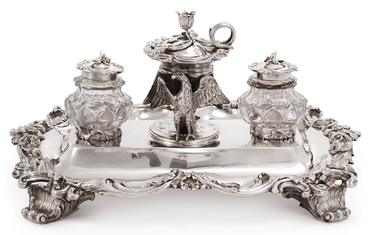|
In the 1950's, if you were lucky enough to live in Chicagoland as I was, you would inevitably encounter the Wanzer milk television commercial starring Carmelita Pope, "Wanzer on milk is like sterling on silver." And no doubt it is. But I went for the cream, not the milk, on this trip to New York, and walked away with seven pieces of highly desirable antique silver. What's more, each piece was acquired at below the low estimate. Each and every one, that is to say all four were as reasonably priced as one could wish, always allowing for the fact that one had to pay something. My Sotheby's representative was astonished that all four of my acquisitions came in at below the low estimate. "How did you do that?", she asked. No cat could have purred a better response. Thus, this report from the silver lining is a testament to my modus operandi: how to acquire more for less. First of all, this desirable outcome can only be the result of prolonged study and application. In short, you have to know what you're talking about. And it has taken me any number of years, plus any number of silver catalogs, from all the major auction houses across the world, to feel reasonably confident that I cannot be completely humbugged, and that, from time to time, I may be fortunate enough to outsmart the experts... which happened with these four pieces. So, let us review my bounty.  Lot 715 First, four silver salad bowls by William Fountain (1819), fluted, the centers engraved with arms, marked on sides below rim. 67 oz 15 dwt; 2108.6 g; diameter 10 1/4 in; 26 cm. This period of English silver is called Regency, after the Prince Regent, later George IV. Every element of the fine arts is stylish and in your face during the Regency. It is almost impossible to buy a bad artifact from the Regency, though many have tried (quite successfully too). And for those of you who have your lunch salad out of a styrofoam container, eat your heart out. I shall be feeding milord and his lady with subdued, unmistakable splendor. By the way, the arms you see on these bowls are those of Neville impaling Cornwallis. You will remember Lord Cornwallis, who surrendered to the Americans at Yorktown, thereby ending the revolution. I hope his salad bowls cheered him up.  Lot 762 My second acquisition is a George II Silver Salver, Edward Feline, London, 1734; circular with lobed border, engraved with strapwork border and arms in a baroque cartouche; marked on base; 16 oz 10 dwt; 516 g; diameter 9 3/4 in; 24.8 cm; the arms are those of probably Aiton quartering Campbell, impaling Bottell, Fraxine or Ponsonby. This dish is part of a set, dating from 1734, about the time English silver begins to be the envy of the world. Lovely, isn't it? When you pop by, I shall be sure to show it to you.  Lot 771 My third acquisition is a Queen Anne silver salver on foot, Jacob Margas, London, 1706; plain circular on trumpet foot, engraved with contemporary arms in baroque cartouche; marked on surface and foot; 15 oz 10 dwt; 485 g; diameter 9 3/4 in; 24.8 cm. The thing you must keep in mind about silver from the reign of Queen Anne (1665-1714), is that it is valuable simplicity. At the Court of Queen Anne, people tried to impress each other (as they always do at a royal court), but it was impressing each other with how little decoration they could get away with, not how much. Anne herself was a plain spoken woman, burdened by too much weight and the death of every child she ever conceived (13). But she knew who she was, and what people say is that the silver from her time is real, actual, not overwhelming, but always valuable.  Lot 779 My fourth acquisition is my only one from this auction from the Victorian age. It is a stunning inkwell, so emblematic of the age in which it was produced. It is heavy, impressive, in your face, bombastic... a thing to be reckoned with, used by the paterfamilias, whose desk in the library it would have graced, saying the the world, "Here's a good English gentlemen, a man of money, reputation, and stern consideration." Here is a description: A Victorian silver large inkstand, Benjamin Preston, London, 1832; on four scrolled shell feet and with bold rococo borders; the central seal box supported by two fully-modeled eagles and topped by a taperstick, fitted with two silver-mounted cut-glass jars; marked throughout; 74 oz weighable; 2301.4 g; length 15 in; 38.1 cm. I shall enjoy placing this stunning object, for it deserves our full attention. It will join what some are now calling the largest collection of inkwells in the world, and perhaps it is... after all, I know a good thing when I see it, and have snapped up any number of inkwells, a suitable emblem for writers, don't you think? All three volumes of Treasures From The Lant collection can be found on Dr. Lant's author page at: http://www.amazon.com/author/jeffreylant/ *** About the author Now 70, a bonafide septuagenarian, Harvard educated Dr. Lant looks upon his much favored life with happiness and joyful acclimation. Author of nearly 60 books and well over 1,000 articles, this is a man who knows how to tell a story and tell it well. To see his complete oeuvre, go to www.drjeffreylant.com. There, you will also find details on our Guaranteed Future Millionaire Club. You'll certainly want to join us.
0 Comments
Leave a Reply. |
AuthorDr. Jeffrey Lant, Harvard educated, started writing for publication at age 5. Since then, he has published over 1,000 articles and 63 books, and counting. Archives
August 2018
Categories |
 RSS Feed
RSS Feed